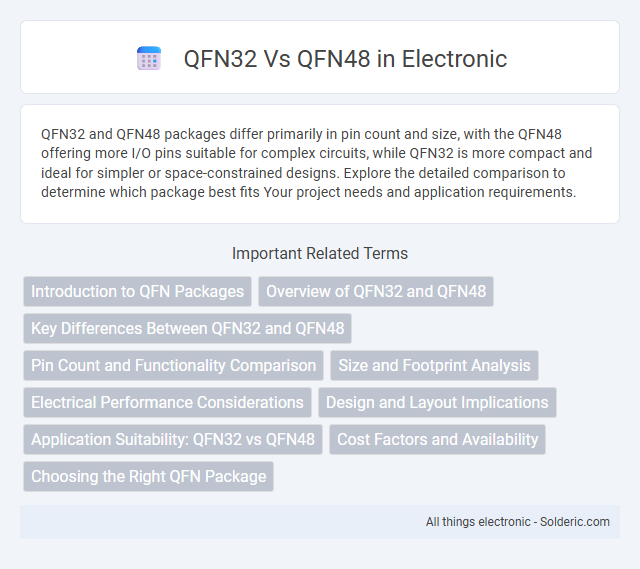QFN32 and QFN48 packages differ primarily in pin count and size, with the QFN48 offering more I/O pins suitable for complex circuits, while QFN32 is more compact and ideal for simpler or space-constrained designs. Explore the detailed comparison to determine which package best fits Your project needs and application requirements.
Comparison Table
| Feature | QFN32 | QFN48 |
|---|---|---|
| Pin Count | 32 pins | 48 pins |
| Package Size | Typically 5mm x 5mm | Typically 7mm x 7mm |
| Pin Pitch | 0.5mm - 0.65mm | 0.5mm - 0.65mm |
| Thermal Performance | Good heat dissipation due to exposed pad | Enhanced thermal performance with larger pad |
| Application | Used for compact, space-limited designs | Ideal for more complex circuits requiring more I/O |
| Cost | Lower cost due to fewer pins | Higher cost but supports advanced features |
Introduction to QFN Packages
QFN32 and QFN48 are types of Quad Flat No-lead (QFN) packages used for integrated circuits, distinguished primarily by their pin count and size. The QFN32 package offers 32 pins in a compact form factor suitable for applications requiring moderate connectivity and space efficiency. In contrast, the QFN48 provides 48 pins, enabling higher pin density and enhanced functionality while maintaining low profile and excellent thermal performance.
Overview of QFN32 and QFN48
QFN32 and QFN48 are types of Quad Flat No-Lead packages commonly used for integrated circuits, distinguished mainly by their pin count with 32 and 48 pins respectively. QFN48 offers more I/O options and greater functionality for complex circuit designs, while QFN32 provides a compact footprint suitable for space-constrained applications. Your choice between QFN32 and QFN48 depends on the required pin configuration and available PCB real estate.
Key Differences Between QFN32 and QFN48
QFN32 and QFN48 packages differ primarily in pin count, with QFN32 offering 32 pins and QFN48 providing 48 pins, impacting their connectivity and functional capacity. The QFN48 supports more complex circuits due to increased I/O availability, making it suitable for applications requiring higher integration and signal routing. Thermal performance and package size also vary, with QFN48 typically larger to accommodate extra pins, influencing board space and heat dissipation requirements.
Pin Count and Functionality Comparison
QFN32 packages typically offer 32 pins, making them suitable for designs requiring moderate I/O connectivity and compact footprints. In contrast, QFN48 packages provide 48 pins, enhancing functionality by supporting more peripheral connections and power options. Your choice between QFN32 and QFN48 depends on the complexity of your circuit and the number of signals or power lines needed for optimal performance.
Size and Footprint Analysis
QFN32 packages typically measure around 5x5 mm with 32 pins, offering a smaller footprint suitable for compact electronic devices. In contrast, QFN48 packages are larger, often 7x7 mm, providing 48 pins for higher pin-count applications requiring more I/O connections. The increased size and pin density of QFN48 enable enhanced functionality but demand more PCB space and careful thermal management.
Electrical Performance Considerations
QFN32 packages typically offer lower parasitic capacitance and inductance compared to QFN48, enhancing signal integrity in high-frequency applications. The smaller pin count of QFN32 reduces potential crosstalk and noise, improving overall electrical performance. However, QFN48 provides more I/O options, which may increase complexity and affect signal routing, potentially introducing additional parasitic effects.
Design and Layout Implications
QFN32 packages offer a more compact footprint that supports higher-density PCB layouts, making them ideal for space-constrained designs. QFN48, with increased pin count, provides enhanced I/O capabilities but requires more complex routing and careful thermal management to maintain signal integrity. Your choice between QFN32 and QFN48 impacts board size, component placement, and overall electrical performance in your design.
Application Suitability: QFN32 vs QFN48
QFN32 packages offer a compact footprint ideal for applications requiring moderate pin counts and space efficiency, such as portable consumer electronics and compact IoT devices. QFN48 packages provide more pins for complex circuitry and enhanced connectivity, suitable for advanced communication equipment and high-performance embedded systems. Choosing between QFN32 and QFN48 depends on your need for pin density versus board space constraints in your specific application.
Cost Factors and Availability
QFN32 packages generally have lower manufacturing costs and better availability due to their smaller pin count and simpler assembly process, making them ideal for budget-sensitive projects. QFN48 packages, with their increased pin density, offer enhanced functionality but often come with higher costs and may have longer lead times due to complexity and demand. Your choice between QFN32 and QFN48 should consider both the budget constraints and the required I/O capabilities of your application.
Choosing the Right QFN Package
Selecting the right QFN package depends on the required pin count and board space constraints; QFN32 offers 32 pins ideal for compact designs with moderate I/O needs, while QFN48 provides 48 pins to accommodate more complex circuits demanding higher connectivity. Thermal performance and electrical characteristics also influence the choice, as larger QFN packages like QFN48 typically exhibit better heat dissipation due to increased exposed pad size. Evaluating the specific application requirements such as signal integrity, power handling, and footprint empowers engineers to optimize functionality and reliability by choosing between QFN32 and QFN48.
QFN32 vs QFN48 Infographic

 solderic.com
solderic.com